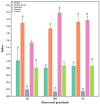The Impact of Artificial Restoration of Alpine Grasslands in the Qilian Mountains on Vegetation, Soil Bacteria, and Soil Fungal Community Diversity
- PMID: 38792684
- PMCID: PMC11123739
- DOI: 10.3390/microorganisms12050854
The Impact of Artificial Restoration of Alpine Grasslands in the Qilian Mountains on Vegetation, Soil Bacteria, and Soil Fungal Community Diversity
Abstract
To understand how the soil microbial community structure responds to vegetation restoration in alpine mining areas, this study specifically examines the grassland ecosystem in the Qianmalong mining area of the Qilian Mountains after five years of artificial restoration. High-throughput sequencing methods were employed to analyze soil bacteria and fungi microbial characteristics in diverse grassland communities. Combined with modifications in vegetation diversity as well as soil physicochemical properties, the impact of vegetation restoration on soil microbiome diversity in this alpine mining area was investigated. The findings indicated that the dominant plants were Cyperus rotundus, Carex spp., and Elymus nutans. As the extent of the grassland's restoration increased, the number of plant species, importance values, and plant community diversity showed an increasing trend. The plant functional groups were mainly dominated by Cyperaceae, followed by Poaceae. Plant height, density, plant cover, frequency, and aboveground biomass showed an increasing trend, and soil water content (SWC) increased. While soil pH and soil electrical conductivity (EC) exhibited a declining trend, available phosphorus (AP), total phosphorus (TP), total nitrogen (TN), nitrate nitrogen (NO3-N), soil organic carbon (SOC), and soil water content (SWC) showed an increasing trend. The dominant bacterial communities were Actinobacteriota, Proteobacteria, Acidobacteriota, Chloroflexi, Firmicutes, and Gemmatimonadota, while the dominant fungal communities were Ascomycota, Mortierellomycota, Basidiomycota, unclassified_k_Fungi, and Glomeromycota. Significant differences were detected within soil microbial community composition among different degrees of restoration grasslands, with bacteria generally dominating over fungi. SWC, TP, and TN were found to be the main soil physicochemical factors affecting the distribution of soil bacterial communities' structure; however, SOC, TN, and NO3-N were the primary factors influencing the soil distribution of fungal communities. The results of this study indicate that different degrees of vegetation restoration in alpine mining areas can significantly affect soil bacterial and fungal communities, and the degree of restoration has varying effects on the soil bacteria and fungi community structure in alpine mining areas.
Keywords: Qilian Mountains; alpine mining area grassland; artificial restoration; microbial diversity; vegetation diversity.
Conflict of interest statement
The authors declare no conflicts of interest.
Figures















Similar articles
-
Effects of vegetation restoration on soil fungi community structure and assembly process in a semiarid alpine mining region.Front Plant Sci. 2025 Jul 4;16:1579142. doi: 10.3389/fpls.2025.1579142. eCollection 2025. Front Plant Sci. 2025. PMID: 40688692 Free PMC article.
-
Vegetation communities and soil properties along the restoration process of the Jinqianghe mine site in the Qilian Mountains, China.Front Plant Sci. 2024 Apr 22;15:1358309. doi: 10.3389/fpls.2024.1358309. eCollection 2024. Front Plant Sci. 2024. PMID: 38711611 Free PMC article.
-
[Response of Microbiological Properties to Short-term Nitrogen Addition in Perennial Alpine Cultivated Grassland].Huan Jing Ke Xue. 2024 Dec 8;45(12):7316-7325. doi: 10.13227/j.hjkx.202312228. Huan Jing Ke Xue. 2024. PMID: 39628195 Chinese.
-
[Impact of Different Vegetation Restoration Types on Soil Microbial Community Structure in the Restoration Area of Quarries in Northern Hebei Province].Huan Jing Ke Xue. 2025 Feb 8;46(2):1213-1224. doi: 10.13227/j.hjkx.202402063. Huan Jing Ke Xue. 2025. PMID: 39962697 Chinese.
-
Effects of Ecosystem Recovery Types on Soil Phosphorus Bioavailability, Roles of Plant and Microbial Diversity: A Meta-Analysis.Ecol Evol. 2025 Apr 25;15(4):e71172. doi: 10.1002/ece3.71172. eCollection 2025 Apr. Ecol Evol. 2025. PMID: 40290384 Free PMC article. Review.
Cited by
-
Effects of vegetation restoration on soil fungi community structure and assembly process in a semiarid alpine mining region.Front Plant Sci. 2025 Jul 4;16:1579142. doi: 10.3389/fpls.2025.1579142. eCollection 2025. Front Plant Sci. 2025. PMID: 40688692 Free PMC article.
-
Effects of underground coal mining disturbance on bacterial community diversity and its assembly processes.PLoS One. 2025 May 7;20(5):e0322014. doi: 10.1371/journal.pone.0322014. eCollection 2025. PLoS One. 2025. PMID: 40333751 Free PMC article.
References
-
- Gao Z.W., Liu Z.Y., Wu Z.H., Huang J., Zhang L., Zhang G.G., Jia M.Q., Han G.D. Soil nematode communities and functions: Ecological package restoration responses in damaged desert steppe open-pit mining ecosystems. Land. Degrad. Dev. 2022;11:1015–1028. doi: 10.1002/ldr.4208. - DOI
-
- Rania R., Joana D., Omar D. A tunnel under an in-pit mine waste dump to improve environmental and landscape recovery of the site. Minerals. 2021;11:2–11.
Publication types
Grants and funding
LinkOut - more resources
Full Text Sources
Research Materials
Miscellaneous

